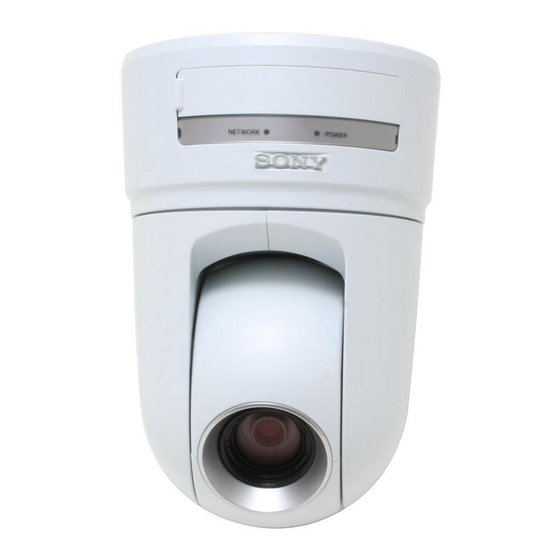Sony SNC-RZ25N - Network Camera Catalog - Page 5
Browse online or download pdf Catalog for Digital Camera Sony SNC-RZ25N - Network Camera. Sony SNC-RZ25N - Network Camera 44 pages. Ntsc/pal
Also for Sony SNC-RZ25N - Network Camera: Reference Manual (2 pages), Quick Reference (20 pages), Brochure & Specs (6 pages), Integration Note (4 pages)

Image Processing Technologies
JPEG vs. MPEG-4
JPEG compression, which is conventionally used in
surveillance and monitoring systems is very good for
capturing high-quality still images. MPEG-4, on the other
hand, is ideal for image transfer over a network while
maintaining high-quality moving images. This is because
MPEG-4 requires a relatively small amount of network
bandwidth as a result of its structure as can be seen
below.
JPEG
MPEG-4
At 30 fps, 1 sec = 30 images
1 GOV ,1 sec. = 1 I-VOP and 29 P-VOPs
3 frames
Note: Each frame in MPEG-4 is referred to as a Video Object Plane (VOP).
A Group of VOPs (GOV) comprises of one second* of video. An I-VOP is the
first (Initial) "frame" of a GOV and is often referred to as an "anchor." The
I-VOP is similar to a JPEG image. P-VOPs are "Predictive" VOPs and only
"captures" movement relative to the previous VOP.
*The default GOV setting for Sony MPEG-4 cameras is one second.
The length of a GOV can be set between one and five seconds.
Rough Calculation of Data Size
JPEG
With JPEG at 30 fps, 1 sec = 30 images. Assuming each
JPEG image is 30 KB in size, then one second of video is
900 KB. At 8 bits per Byte, this translates to 7.2 Mb/s
MPEG-4
With MPEG-4, the I-VOP is approximately 30 KB in size.
Assuming there is little movement in the image, each
P-VOP is approximately 2 KB in size. This means that 1
second of data is approximately 88 KB. Again, using the
same calculations as above, this translates to
704 Kb/s. This is approximately 1/10th the size of
JPEG data.
4
I-VOP
VOPs
Activity Detection vs. Motion Detection
(SNC Series Cameras)
The following is a brief explanation outlining the
differences between Motion Detection and Activity
Detection: The general difference in concept between the
two detection methods is that Motion Detection utilizes
vector information associated with movement while
Activity Detection utilizes the difference in illumination
between frames. Activity Detection is available with JPEG
compression while Motion Detection is available with
MPEG-4 compression.
Activity Detection
Sony Activity Detection systems utilize hardware that
performs difference calculations in luminance between
frames. The absolute value of the difference in luminace
of each pixel is taken from one frame to the next. If the
sum of the difference is greater than a preset threshold,
then an alarm is triggered.
Motion Detection
Motion Detection systems utilize a Sony advanced
algorithm to determine whether or not there is actual
movement in the camera viewing area. This algorithm is
based on vector information available and inherent in
MPEG-4 compression. The vector information is
determined based on the amount of movement in 16 x 16
pixel-areas in the grid.
Motion Detection has an advantage over Activity
Detection because it can reduce the number of false
alarms caused by noise. Other advantages of Sony
systems that use Motion Detection are that up to four
distinct Motion Detection areas can be assigned, and real
time indicators are available to monitor sensitivity and
threshold levels.
Detection by average Change
in luminance of pixels
Detection by average Change
16 pixels
in luminance of pixels
16 pixels
